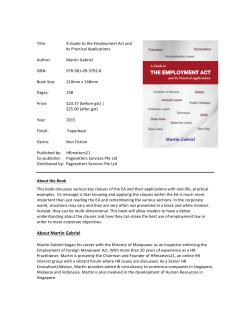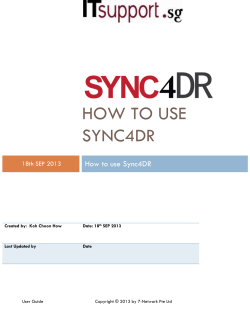
now
Chronic Thromboembolic Pulmonary Hypertension (CTEPH): Myths Regarding CTEPH and Its Management To learn more, go to CTEPH.com CTEPH Definition C hronic thromboembolic pulmonary hypertension, or CTEPH, is defined as mean pulmonary arterial pressure (mPAP) of at least 25 mmHg and pulmonary capillary wedge pressure (PCWP) of no more than 15 mmHg in the presence of multiple chronic or organized occlusive thrombi or emboli in the elastic pulmonary arteries (the main, lobar, segmental, subsegmental) after at least 3 months of effective anticoagulation. Defining CTEPH After 3 months of therapeutic anticoagulation •m PAP ≥25 mmHg •P CWP ≤15 mmHg •C hronic/organized occlusive thrombi/emboli CTEPH is a complex and misunderstood disease, and numerous myths about CTEPH and its treatment persist. Here, we present evidence that should help dispel some commonly held myths about the diagnosis of CTEPH and about pulmonary thromboendarterectomy (PTE) surgery, the only potentially curative treatment for CTEPH. Diagnosis • A prospective follow-up study by Pengo et al of 314 consecutive patients MYTH: If a patient recovers from an acute pulmonary embolism, she won’t go on to develop CTEPH. E vidence: While the likelihood of developing CTEPH after an acute pulmonary embolism (PE) is small, it is not negligible. CTEPH is a rare complication of a common disease. found that 3.8% eventually developed CTEPH within 2 years of their first symptomatic episode of acute PE •There are several factors that increase the risk that CTEPH will eventually develop subsequent to an acute PE. These include: –Large perfusion defects –Recurrent or idiopathic PE –Young or old age –Persistent PH 6 months after the embolism has occurred –Systolic PAP >50 mmHg at initial manifestation of PE •Recognizing this risk, the ACCF/AHA 2009 expert consensus document on pulmonary hypertension (PH) recommends that a ventilation/perfusion (V/Q) scan be performed in patients who show symptoms of PH 3 months after having an acute PE •Studies report that about a quarter to as many as 63% of CTEPH patients may present without a history of acute PE or deep vein thrombosis Pengo V et al. N Engl J Med. 2004;350:22572264. Piazza G, Goldhaber SZ. N Engl J Med. 2011;364:351-360. McLaughlin VV et al. Circulation. 2009;119:2250-2294. Lang IM. N Engl J Med. 2004;350:2236-2238. PepkeZaba J et al. Circulation. 2011;124:1973-1981. To learn more about CTEPH, please visit CTEPH.com Chronic Thromboembolic Pulmonary Hypertension (CTEPH): Myths Regarding CTEPH and Its Management E MYTH: The V/Q is unnecessary in the evaluation of pulmonary hypertension. S C vidence: Multiple PH guidelines— including those from the Fifth World Symposium on Pulmonary Hypertension (WSPH) CTEPH Task Force—recommend that the V/Q scan be considered an essential CTEPH screening tool as part of the PH diagnostic algorithm. The diagram below communicates a mnemonic, SCAR, developed by the WSPH CTEPH Task Force. Along with echocardiography, the V/Q scan provides information that leads to a suspicion of CTEPH, but it is only with right heart catheterization (RHC) and pulmonary angiography that a diagnosis of CTEPH can be confirmed. Suspect • Echocardiogram •V /Q scan Confirm • Right heart catheterization • Pulmonary angiogram (or CTPA, MRA) A R •Computed tomographic pulmonary angiography (CTPA) may be used to provide complementary diagnostic information, but it does not replace the V/Q scan as a screening test –In a retrospective study of 227 patients, Tunariu et al reported CTPA had a sensitivity for detecting CTEPH of 51%, while the V/Q scan had a sensitivity >96% –The WSPH noted that use of CTPA as a screening tool instead of V/Q scanning, “may lead to potential misdiagnosis of PAH and underdiagnosis of CTEPH” Assess Risk • Hemodynamics • Comorbidities • Surgeon/CTEPH team experience •The V/Q scan is the preferred and recommended method of screening for CTEPH –Every patient being evaluated for PH should undergo a V/Q scan if CTEPH has not already been excluded by a prior normal V/Q scan Galiè N et al. Eur Heart J. 2009;30:24932537. Kim NH et al. J Am Coll Cardiol. 2013; 62:D92-D99. Tunariu N et al. J Nucl Med. 2007;48:680-684. V/Q scan showing perfusion defects. Image courtesy of Dr Paul Forfia, Right Heart Failure, and Pulmonary Thromboendarterectomy Program at Temple University Hospital, Philadelphia. To learn more about CTEPH, please visit CTEPH.com Chronic Thromboembolic Pulmonary Hypertension (CTEPH): Myths Regarding CTEPH and Its Management Assessing Operability For PTE Surgery •A recent study from the UK of a cohort MYTH: PTE surgery cannot be safely performed in patients who have more severe PH or who are elderly, obese, or otherwise very sick. E vidence: There are no absolute contraindications to PTE surgery based on severity of pulmonary hypertension, age, body mass index, or presence of comorbidities. •Madani and colleagues from University of California, San Diego (UCSD) reported a series of 500 patients who had PTE surgery and found that among the patients who had preoperative pulmonary vascular resistance (PVR) >1000 dynes, which indicates comparatively severe pulmonary hypertension, overall mortality was 4.1% vs 1.6% in patients who had preoperative PVR <1000 of 411 total patients (see table below), including 103 who were aged 70 or more years, showed that short-term in-hospital mortality rates did not significantly differ between the younger and the older patients: 4.6% vs 7.8% Berman M et al. Eur J Cardiothorac Surg. 2012;41:e154-160. •A recent analysis of data collected by researchers at UCSD evaluated outcomes after PTE for CTEPH in a cohort that included 120 patients who were obese (body mass index [BMI] >30) and 208 patients who were not obese (BMI<30) demonstrated no significant difference in mortality (2.4% for obese vs 0.8% for nonobese patients) or post-PTE hemodynamics between the groups Kerr KN et al. Am J Respir Crit Care Med. 2013;187:A3316. •Patients who have underlying cardiovascular disease may be able to undergo corrective procedures— eg, valve replacement or coronary artery bypass grafting—at the same time as PTE •Those with hepatic or renal insufficiency at baseline may have complications during the perioperative period, but in the long term, hepatic and renal function may improve along with the general improvements in CTEPH following PTE surgery Thistlethwaite PA. Ann Thorac Surg. 2001;72: 13-19. Marshall PS et al. Clin Chest Med. 2013;34:779-797. Any major surgery may pose a greater risk for older patients as compared with younger patients. Similarly, obesity, serious comorbidities, and severity of PH certainly need to be considered by the experienced CTEPH team assessing a patient’s operability for PTE surgery. However, none of these factors automatically disqualifies patients from potentially curative PTE surgery. Madani M et al. Ann Thorac Surg. 2012:94: 97-103. Comparable mortality rates in older and younger patients (1/2006-3/2011) Time Frame <70 years, n=308 ≥70 years, n=103 P In hospital 4.6% 7.8% .21 1 year 8.6% 14.1% 2 year 10.1% 15.9% 3 year 12.3% 15.9% .07 To learn more about CTEPH, please visit CTEPH.com Chronic Thromboembolic Pulmonary Hypertension (CTEPH): Myths Regarding CTEPH and Its Management PTE Surgery MYTH: PTE surgery is still an experimental and dangerous procedure. E vidence: PTE surgery is not experimental. Rather, it’s a wellestablished, reproducible procedure that represents the only potential cure for patients who have CTEPH. • The PTE surgical technique was developed and first performed in 1970. – The blue table documents the PTE history of a single experienced center. Mortality rates have consistently decreased, such that none of their last 260 PTEs, as reported by Madani et al in 2012, resulted in death Jamieson SW et al. Ann Thorac Surg. 2003; 76:1457-1464. Madani MM et al. Ann Thorac Surg. 2012;94:97-103. • Since its inception over 4 decades ago, the safety of PTE surgery has improved markedly, such that experienced centers have been able to achieve in-hospital mortality rates of <5% Jenkins DP et al. Eur Respir J. 2013;41:735742. Mortality data post-PTE at a single experienced center Timeline N 1970-1990 200 1994-1998 500 1998-2002 500 1999-2006 1000 2006-2010 500 Last consecutive patients 260 up to 12/2010 – The green table shows mortality there are about 300 PTE • Today, – At the most experienced centers, • rates reported by 27 centers stratified by the number of PTEs performed each year, a measure of surgical experience 96.5% survive to discharge Mayer et al. J Thorac Cardiovasc Surg. 2011; 141:702-710. Drug therapy can be used in place of PTE surgery. Registry data: 26 European, 1 Canadian center (2/2007-1/2009, n=386 patients with PTE) Average no. of PTE per year In-hospital deaths Deaths 1 year after PTE 1-10 E 11-50 >50 Combined 7.4%4.7%3.5% 4.7% 11.1% is the standard and recommended • PTE treatment for CTEPH, and it is the only treatment option that can potentially cure CTEPH. from the WSPH makes it • Guidance vidence: According to the WSPH CTEPH Task Force, drug therapy is surgeries performed each year in the US, and the geographic distribution of experienced centers spans the continental United States PTE surgery provides lasting symptomatic and hemodynamic benefit to most patients who undergo it Mayer E. Eur Respir Rev. 2010;19:64-67. no substitute for PTE in a CTEPH patient who has operable disease. MYTH: Mortality 17% 8.8% 4.4% 5.2% 2.2% 0% clear that all patients with CTEPH should be assessed for operability, and those who have operable disease 7.3% 6.0% should be referred for PTE without delay. the role of “bridging” with • Furthermore, drug therapy in CTEPH has not been sufficiently studied and should be reserved for controlled investigation. Kim NH et al. J Am Coll Cardiol. 2013;62:D92-D99. To learn more about CTEPH, please visit CTEPH.com This material was reviewed by Gustavo Heresi-Davila, MD, of Cleveland Clinic, Cleveland OH and Ivan M. Robbins, MD, of Vanderbilt University Medical Center, Nashville TN. Bayer HealthCare LLC 100 Bayer Boulevard, Whippany, NJ 07981 USA ©2015 Bayer HealthCare Inc. PP-400-US-1773. May 2015 7.0%
© Copyright 2025









